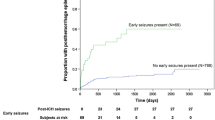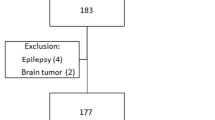Abstract
Introduction
Intracerebral hemorrhage (ICH) is associated with a risk of early seizure and guidelines recommend consideration of prophylactic antiepileptic drugs (AEDs) for some patients, although the utility is uncertain.
Methods
We analyzed data from the placebo arm of the Cerebral Hemorrhage and NXY-059 Trial (CHANT), an international multicenter randomized trial of a potential neuroprotectant that enrolled patients within 6 h of the onset of acute ICH. Logistic regression analyses were performed to determine whether early AED use was associated with poor outcome at day 90, defined as a modified Rankin Scale of 5 or 6 (severely disabled or dead).
Results
Excluding patients who were previously on AEDs, the primary analysis included 295 patients. The median ICH volume at admission was 14.9 (interquartile range, IQR 7.9–32.7) ml and the mean was 23.3 (±SD 22.8) ml. Seizures occurred in 5 patients (1.7%) after enrollment and 82 patients (28%) had a poor outcome at day 90. AEDs were initiated on 23 patients (8%) without documented seizure during the first 10 days of the trial. In logistic regression, initiation of AEDs was robustly associated with poor outcome (OR 6.8; 95% CI: 2.2–21.2, P = 0.001) after adjustment for other known predictors of outcome after ICH (age, initial hematoma volume, presence of intraventricular blood, initial Glasgow coma score, and prior warfarin use).
Conclusions
In this clinical trial cohort, seizures were rare after the first few hours following ICH. In addition, prophylactic AED use was associated with poor outcome independent of other established predictors. Given the potential for residual confounding in this cohort, a randomized trial needs to be performed.

Similar content being viewed by others
References
Broderick J, Connolly S, Feldmann E, et al. Guidelines for the management of spontaneous intracerebral hemorrhage in adults: 2007 update: a guideline from the American Heart Association/American Stroke Association stroke council, high blood pressure research council, and the quality of care and outcomes in research interdisciplinary working group. Circulation. 2007;116:e391–413. doi:10.1161/CIRCULATIONAHA.107.183689.
Passero S, Rocchi R, Rossi S, Ulivelli M, Vatti G. Seizures after spontaneous supratentorial intracerebral hemorrhage. Epilepsia. 2002;43:1175–80. doi:10.1046/j.1528-1157.2002.00302.x.
Berger AR, Lipton RB, Lesse ML, Lantos G, Portenoy RK. Early seizures following intracerebral hemorrhage: implications for therapy. Neurology. 1988;38:1363–5.
Steiner T, Kaste M, Forsting M, et al. Recommendations for the management of intracranial haemorrhage—part I: spontaneous intracerebral haemorrhage. The European Stroke Initiative writing committee and the writing committee for the EUSI executive committee. Cerebrovasc Dis. 2006;22:294–316.
Bladin CF, Alexandrov AV, Bellavance A, et al. Seizures after stroke: a prospective multicenter study. Arch Neurol. 2000;57:1617–22. doi:10.1001/archneur.57.11.1617.
Camilo O, Goldstein LB. Seizures and epilepsy after ischemic stroke. Stroke. 2004;35:1769–75. doi:10.1161/01.STR.0000130989.17100.96.
Naidech AM, Kreiter KT, Janjua N, et al. Phenytoin exposure is associated with functional and cognitive disability after subarachnoid hemorrhage. Stroke. 2005;36:583–7. doi:10.1161/01.STR.0000141936.36596.1e.
Rosengart AJ, Huo JD, Tolentino J, et al. Outcome in patients with subarachnoid hemorrhage treated with antiepileptic drugs. J Neurosurg. 2007;107:253–60. doi:10.3171/JNS-07/08/0253.
NINDS ICH Workshop Participants. Priorities for clinical research in intracerebral hemorrhage: Report from a National Institute of Neurological Disorders and Stroke workshop. Stroke. 2005;36:e23–41. doi:10.1161/01.STR.0000155685.77775.4c.
Lyden PD, Shuaib A, Lees KR, et al. Safety and tolerability of NXY-059 for acute intracerebral hemorrhage: the CHANT trial. Stroke. 2007;38:2262–9. doi:10.1161/STROKEAHA.106.472746.
Mayer SA, Brun NC, Begtrup K, et al. Efficacy and safety of recombinant activated factor VII for acute intracerebral hemorrhage. N Engl J Med. 2008;358:2127–37. doi:10.1056/NEJMoa0707534.
Hosmer DW, Lemshow S. Applied logistic regression. New York: John Wiley & Sons, Inc.; 1989.
Hemphill JC III, Bonovich DC, Besmertis L, Manley GT, Johnston SC. The ICH score: a simple, reliable grading scale for intracerebral hemorrhage. Stroke. 2001;32:891–7.
Rosand J, Eckman MH, Knudsen KA, Singer DE, Greenberg SM. The effect of warfarin and intensity of anticoagulation on outcome of intracerebral hemorrhage. Arch Intern Med. 2004;164:880–4. doi:10.1001/archinte.164.8.880.
Clarke JL, Johnston SC, Farrant M, Bernstein R, Tong D, Hemphill JC 3rd. External validation of the ICH score. Neurocrit Care. 2004;1:53–60. doi:10.1385/NCC:1:1:53.
Vespa PM, O’Phelan K, Shah M, et al. Acute seizures after intracerebral hemorrhage: a factor in progressive midline shift and outcome. Neurology. 2003;60:1441–6.
Leira R, Davalos A, Silva Y, et al. Early neurologic deterioration in intracerebral hemorrhage: predictors and associated factors. Neurology. 2004;63:461–7.
Szaflarski JP, Rackley AY, Kleindorfer DO, et al. Incidence of seizures in the acute phase of stroke: a population-based study. Epilepsia. 2008;49:974–81. doi:10.1111/j.1528-1167.2007.01513.x.
Labovitz DL, Allen Hauser W, Sacco RL. Prevalence and predictors of early seizure and status epilepticus after first stroke. Neurology. 2001;57:200–6.
Burn J, Dennis M, Bamford J, Sandercock P, Wade D, Warlow C. Epileptic seizures after a first stroke: the Oxfordshire Community Stroke Project. BMJ. 1997;315:1582–7.
Kilpatrick CJ, Davis SM, Tress BM, Rossiter SC, Hopper JL, Vandendriesen ML. Epileptic seizures in acute stroke. Arch Neurol. 1990;47:157–60.
Claassen J, Jette N, Chum F, et al. Electrographic seizures and periodic discharges after intracerebral hemorrhage. Neurology. 2007;69:1356–65. doi:10.1212/01.wnl.0000281664.02615.6c.
Ryvlin P, Montavont A, Nighoghossian N. Optimizing therapy of seizures in stroke patients. Neurology. 2006;67:S3–9.
Castellanos M, Leira R, Tejada J, Gil-Peralta A, Davalos A, Castillo J. Predictors of good outcome in medium to large spontaneous supratentorial intracerebral haemorrhages. J Neurol Neurosurg Psychiatry. 2005;76:691–5. doi:10.1136/jnnp.2004.044347.
Broderick JP, Adams HP, Barsan W, et al. Guidelines for the management of spontaneous intracerebral hemorrhage. Stroke. 1999;30:905.
Sung CY, Chu NS. Epileptic seizures in intracerebral haemorrhage. J Neurol Neurosurg Psychiatry. 1989;52:1273–6. doi:10.1136/jnnp.52.11.1273.
Faught E, Peters D, Bartolucci A, Moore L, Miller PC. Seizures after primary intracerebral hemorrhage. Neurology. 1989;39:1089–93.
Arboix A, Comes E, Massons J, Garcia L, Oliveres M. Relevance of early seizures for in-hospital mortality in acute cerebrovascular disease. Neurology. 1996;47:1429–35.
Strom BL. Methodologic challenges to studying patient safety and comparative effectiveness. Med Care. 2007;45:S13–5.
Acknowledgments
Astra Zeneca, PLC was the primary sponsor of the Cerebral Hemorrhage and NXY-059 Trial (CHANT). They provided no funding for this analysis of the placebo arm of the CHANT study.
Author information
Authors and Affiliations
Consortia
Corresponding author
Rights and permissions
About this article
Cite this article
Messé, S.R., Sansing, L.H., Cucchiara, B.L. et al. Prophylactic Antiepileptic Drug Use is Associated with Poor Outcome Following ICH. Neurocrit Care 11, 38–44 (2009). https://doi.org/10.1007/s12028-009-9207-y
Received:
Accepted:
Published:
Issue Date:
DOI: https://doi.org/10.1007/s12028-009-9207-y




